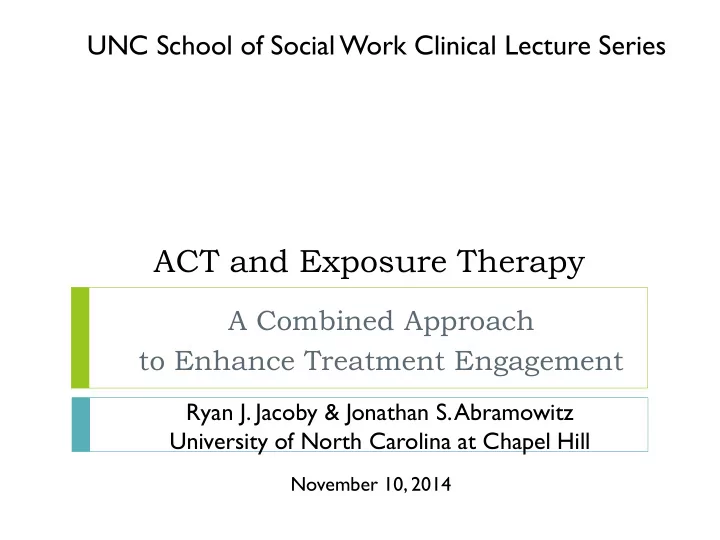

UNC School of Social Work Clinical Lecture Series ACT and Exposure Therapy A Combined Approach to Enhance Treatment Engagement Ryan J. Jacoby & Jonathan S. Abramowitz University of North Carolina at Chapel Hill November 10, 2014
Outline ERP and ACT: What are they and how do they work? Similarities and differences Synthesizing ERP and ACT (“Acceptance - Based ERP”) Why? T echniques to help the patient understand how OCD works Treatment rationale Shifting from anxiety to willingness Focusing on values Implementing ERP from an acceptance perspective
Exposure and Response Prevention (ERP) for OCD Theoretical basis Learning theory of classical and operant conditioning Basic techniques Confront fears (in vivo, imaginal) Resist urges to perform rituals Observe levels of anxiety (SUDS) Mechanisms of action Habituation Inhibitory learning Outcome studies Consistently demonstrates strong efficacy Some concerns about acceptability and drop out
Acceptance and Commitment Therapy (ACT) for OCD Theoretical basis Relational frame theory (RFT): cognitions, emotions, and behaviors in relation to one another and to their histories (“functional contextualism ”) OCD results from experiential avoidance Basic techniques Experiential metaphors to address 6 core processes (e.g., acceptance, defusion, values) Mechanisms of action Enhances psychological flexibility Outcome studies Promising; more work needed
ERP and ACT How are they similar? Focus on changing behavior Broaden patient’s engagement with feared stimuli How is ACT different from ERP? Explicit focus on values Not concerned about levels of anxiety/fear No explicit focus on cognitive change Less directive (no instructions to confront fears or resist rituals) Relies more on the use of metaphors
Synthesizing ERP and ACT “ Acceptance-Based ERP”
Why “Acceptance - Based ERP”? Improve adherence and tolerance Enhance patients’ understanding of OCD and its treatment Dissatisfaction with the habituation model Synergy
Understanding how OCD works An ACT perspective on OCD: 3 parts OCD related inner experiences Attempts to resist and control these experiences Interference with quality of life Man in the hole metaphor
Treatment rationale Shifting focus from the “anxiety scale” to the “willingness scale” Emphasizing values Choosing what direction one wants life to take (not letting OCD choose the direction life goes) Examples from OCD patients Values bull's-eye Moving through a swamp metaphor
BULL’S EYE ILLUSTRATION My life is just as I My life is far from What do you value? want it to be how I want it to be beifrån det jag What do you want your life to be about? Work/ Leisure Education What do each of these categories mean to you? In what ways has OCD been getting in the way of living life in the direction Personal growth/ Relationships of your values? Health
BULL’S EYE ILLUSTRATION Work/ Leisure Education • Keeping a work-life • High quality work balance Adding to society • • Continual self- improvement • Self-care • Quality time with • Being a spiritual / friends and family religious person • Supporting others Personal growth/ Relationships Health
Moving through a swamp Swamp = OCD-related inner experiences and triggers Exposure = learning how to handle whatever comes up while still moving forward through swamp Willingness to go into the swamp without resisting (avoiding or using compulsive rituals) Why are we doing this? Getting dirty and muddy but for a purpose Not wallowing in the swamp Things you value are on the other side of the swamp (only way is through it!)
Implementing ERP from an acceptance perspective I Metaphors to set up exposures “Jerk at the door” Chessboard Tug of war with a monster Passengers on the bus Milk, Milk, Milk
Implementing ERP from an acceptance perspective II Exposures to increase willingness vs. to reduce anxiety Choose hierarchy items based on interference with quality of life Emphasize increasing willingness to experience obsessional distress Rating willingness instead of SUDS Response prevention based on values
Questions and Discussion
Thank you!
Recommend
More recommend